The Solar Street Lighting Market is estimated at USD 5.4 billion in 2025 and is projected to reach USD 11.0 billion by 2035, registering a CAGR of 7.4%. The market demonstrates a clear trajectory in price evolution and average selling price (ASP) trends, reflecting gradual shifts in component costs, technology adoption, and efficiency improvements over the forecast period. In the early years, 2025 to 2027, ASPs remain relatively stable, with incremental increases from USD 5.4 billion to USD 6.2 billion as initial deployments focus on standard solar modules and conventional battery technologies.
Between 2028 and 2032, ASP trends indicate a moderate upward adjustment, rising from USD 6.7 billion to USD 8.9 billion, driven by the integration of higher-efficiency photovoltaic cells, smart lighting controls, and longer-life energy storage solutions. This period also sees cost pressures from advanced LED luminaires and IoT-enabled monitoring systems being partially offset by scale economies and improved manufacturing processes. From 2033 to 2035, the market demonstrates continued but controlled ASP growth, reaching USD 11.0 billion by the end of the forecast period.
Incremental enhancements in light output per watt, adaptive lighting systems, and longer battery life spans contribute to value addition while keeping the price increase manageable. The market reflects a measured ASP evolution aligned with technological advancements, regulatory incentives, and broader adoption trends across urban and semi-urban infrastructure projects.
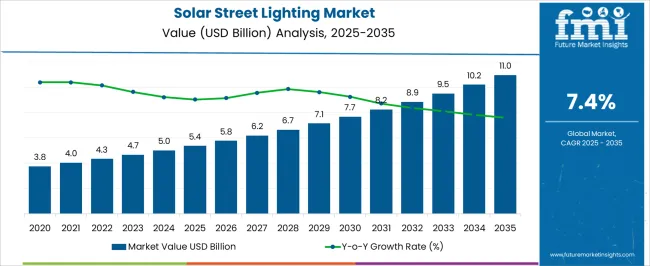
| Metric | Value |
|---|---|
| Solar Street Lighting Market Estimated Value in (2025 E) | USD 5.4 billion |
| Solar Street Lighting Market Forecast Value in (2035 F) | USD 11.0 billion |
| Forecast CAGR (2025 to 2035) | 7.4% |
The solar street lighting market is expanding rapidly, driven by the global push toward renewable energy adoption and sustainable urban infrastructure development. Increasing concerns about energy costs and carbon emissions have prompted governments and municipalities to invest in eco-friendly lighting solutions.
Advances in solar panel efficiency, battery storage technologies, and LED lighting have significantly improved the performance and reliability of solar street lights. These improvements have made solar lighting a preferred choice in both urban and remote areas where grid connectivity is limited or unreliable.
Moreover, the reduction in installation and maintenance costs compared to traditional street lighting has accelerated adoption. The market outlook is further supported by policy initiatives promoting clean energy and smart city projects. Segment growth is expected to be led by the standalone product category, favored for its ease of deployment and independence from grid infrastructure, and commercial applications where demand for efficient outdoor lighting is high.
The solar street lighting market is segmented by product, application, and region. By product, it is divided into standalone and grid-connected systems. By application, it is classified into commercial, residential, and industrial sectors. Regionally, the market is categorized into North America, Latin America, Western Europe, Eastern Europe, Balkan & Baltic Countries, Russia & Belarus, Central Asia, East Asia, South Asia & Pacific, and the Middle East & Africa.

The standalone segment is projected to hold 61.8% of the solar street lighting market revenue in 2025, maintaining its position as the dominant product type. This segment has grown due to its self-sufficient design that does not rely on external power sources, allowing installation in areas lacking electrical infrastructure.
Standalone solar street lights offer flexibility in placement and reduce the need for costly wiring and trenching work. Users have appreciated the reduced operational costs and the ability to maintain lighting during power outages.
Additionally, advancements in battery technologies have extended the autonomy of standalone systems, ensuring consistent illumination. The modularity and scalability of standalone units have also made them popular in both new installations and retrofit projects. As urban and rural areas seek sustainable lighting solutions, the standalone segment is expected to continue its growth trajectory.

The commercial application segment is projected to contribute 49.2% of the solar street lighting market revenue in 2025, solidifying its position as the leading application sector. Growth in this segment is driven by the increasing need for secure and energy-efficient outdoor lighting in business parks, shopping centers, campuses, and public spaces.
Commercial entities have prioritized solar street lighting to reduce operational expenses and demonstrate commitment to sustainability goals. Enhanced lighting quality and smart control features have improved safety and visibility in commercial areas, contributing to increased adoption.
Furthermore, government incentives and environmental regulations encouraging renewable energy use in commercial infrastructure have supported market growth. With expanding commercial real estate developments and increasing emphasis on green building certifications, the commercial application segment is expected to maintain its leadership in the solar street lighting market.
The market has been expanding due to the increasing demand for sustainable, off-grid, and energy-efficient outdoor lighting solutions. These systems have been widely utilized in urban streets, highways, residential areas, and public spaces to reduce electricity consumption and operational costs. Market growth has been supported by advancements in LED technology, solar panels, and battery storage solutions. Rising awareness of renewable energy, government initiatives, and infrastructure modernization projects have further strengthened the adoption of solar street lighting globally.
The growing emphasis on improving public lighting infrastructure has been a major driver of the solar street lighting market. Urban municipalities and rural communities have increasingly installed solar street lighting systems to reduce electricity dependency, improve safety, and ensure uninterrupted illumination in remote areas. Integration with LED lamps has lowered energy consumption while extending operational life. Solar-powered systems have provided a cost-effective alternative to conventional grid-connected lighting, particularly in regions with unreliable power supply or high energy tariffs. Governments and local authorities have supported deployment through grants, subsidies, and public-private partnerships, enabling large-scale installations. Additionally, these systems have contributed to reduced carbon footprints and enhanced public safety, making them a preferred solution for both urban and rural lighting projects worldwide.
Technological innovations have improved the efficiency, durability, and functionality of solar street lighting systems. Advanced solar panels with higher conversion efficiency, long-life lithium-ion and gel batteries, and smart LED controllers have optimized energy storage and consumption. Remote monitoring, adaptive lighting controls, and motion sensors have enhanced operational flexibility while reducing maintenance requirements. Modular and compact designs have facilitated easy installation and replacement, while corrosion-resistant poles and durable luminaries have increased lifespan under harsh weather conditions. Innovations in lighting optics have ensured uniform illumination and reduced light pollution. These technological developments have made solar street lighting systems more reliable, cost-effective, and suitable for diverse applications, driving adoption in both developed and emerging markets globally.
Policy measures, renewable energy mandates, and urban development programs have significantly influenced the solar street lighting market. Governments in multiple regions have incentivized adoption through subsidies, tax benefits, and funding for smart city and rural electrification projects. Standards for energy efficiency, safety, and durability have guided procurement and installation of solar street lighting systems. Public awareness campaigns and regulatory frameworks for clean energy solutions have accelerated acceptance among municipalities and private developers. Compliance with environmental and energy-saving regulations has reinforced the deployment of solar-powered lighting infrastructure. The combination of supportive policies, sustainability goals, and public safety requirements has strengthened the global market for solar street lighting and encouraged further investments.
The integration of Internet of Things (IoT) technologies and smart lighting solutions has created new opportunities in the solar street lighting market. Remote monitoring, automated dimming, adaptive illumination, and predictive maintenance have enhanced operational efficiency and cost savings. Data-driven systems allow real-time control of lighting intensity, energy usage, and system health, improving performance and reliability. The rise of smart city initiatives, connected infrastructure projects, and intelligent transportation systems has increased demand for advanced solar street lighting networks. The combination of renewable energy, energy storage innovations, and smart monitoring is expected to drive long-term adoption in urban, suburban, and rural areas worldwide, positioning solar street lighting as a critical component of sustainable infrastructure development.
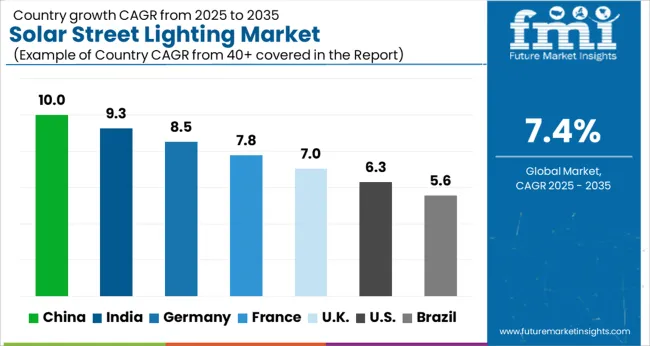
The market is anticipated to grow at a CAGR of 7.4% from 2025 to 2035, driven by increasing adoption of renewable energy, declining solar panel costs, and government initiatives for sustainable urban lighting. China leads with a 10.0% CAGR, fueled by nationwide electrification projects and smart city deployments. India follows at 9.3%, with growth supported by rural electrification programs and urban modernization. Germany, at 8.5%, benefits from strong renewable energy policies and incentives for energy-efficient lighting. The UK, growing at 7.0%, emphasizes sustainable public infrastructure, while the USA, at 6.3%, experiences steady adoption through municipal and state-level renewable energy projects. This report includes insights on 40+ countries; the top markets are shown here for reference.
The industry in China is projected to grow at a CAGR of 10.0% from 2025 to 2035, driven by nationwide initiatives for renewable energy adoption and smart city infrastructure development. Municipalities are replacing conventional street lights with solar-powered LED systems to reduce energy costs and carbon emissions. Key players such as Philips Lighting and Suntech Power are focusing on high-efficiency solar panels and integrated battery storage solutions. Adoption is higher in metropolitan areas with traffic-dense zones and industrial parks. Regional governments are offering incentives to encourage deployment in suburban and rural areas. The integration of IoT-enabled control systems further enhances operational efficiency and reduces maintenance costs.
Sales of solar street lighting in India are expected to expand at a CAGR of 9.3% over 2025 to 2035, supported by government initiatives under the Smart Cities Mission and renewable energy targets. Increasing electricity costs and unreliable grid connectivity in rural regions are driving demand for autonomous solar lighting systems. Companies such as Havells and Tata Power Solar are launching robust solutions with higher battery backup and longer lifespan. Urban centers are prioritizing the installation of energy-efficient and low-maintenance LED systems, while local governments subsidize large-scale projects.
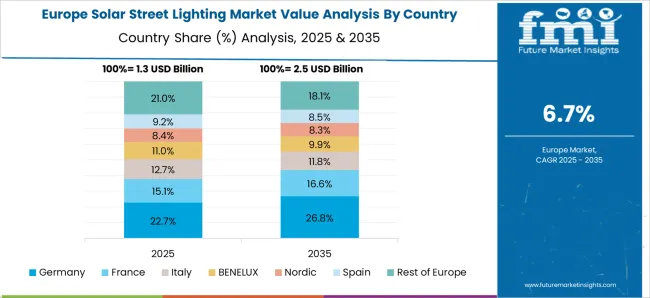
The market in Germany is anticipated to grow at a CAGR of 8.5% from 2025 to 2035, driven by stringent energy efficiency regulations and renewable energy policies. Municipalities are replacing conventional street lighting with solar LED systems to achieve carbon reduction goals. Industry leaders such as Osram and Zumtobel are focusing on modular lighting designs with high-efficiency photovoltaic modules. Integration with smart city solutions allows adaptive lighting based on traffic density and environmental conditions, enhancing sustainability. Retrofits in historical towns and infrastructure modernization projects further increase adoption.
The United Kingdom solar street lighting industry is forecast to grow at a CAGR of 7.0% between 2025 and 2035, driven by initiatives to reduce public energy expenditure and increase renewable energy integration. Urban councils and private developers are adopting solar-powered LED systems to minimize operational costs. Leading suppliers like Philips and Eco-Wise are introducing solutions with improved battery storage and smart dimming functions. Infrastructure upgrades in public spaces, highways, and parking lots are supporting market expansion.
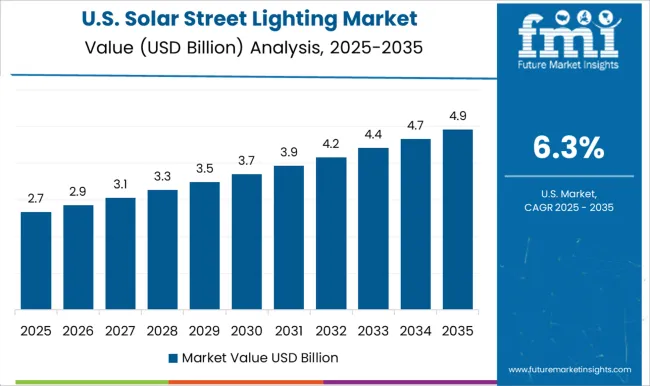
The United States market for solar street lighting is projected to grow at a CAGR of 6.3% over 2025 to 2035, fueled by federal and state incentives for renewable energy adoption. Deployment is concentrated in suburban communities, highway corridors, and commercial zones to reduce electricity costs and carbon footprint. Manufacturers including GE Lighting and SunPower are introducing LED systems with integrated smart controls and extended battery life. Municipal and county governments are implementing pilot projects to evaluate cost-effectiveness, driving further adoption.
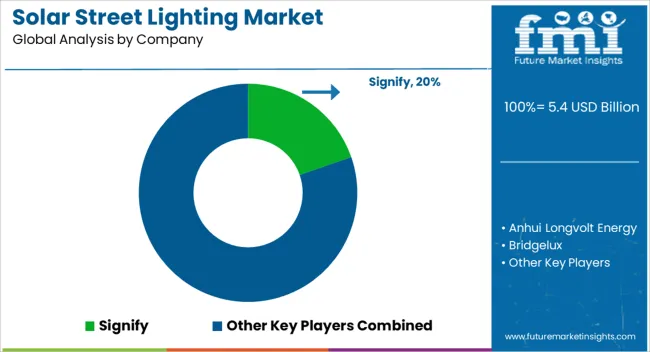
The market is experiencing strong growth driven by the adoption of renewable energy, cost-efficient lighting solutions, and enhanced durability for outdoor environments. Signify has emerged as a leading player by offering smart solar luminaires integrated with advanced LED technology and IoT connectivity. Anhui Longvolt Energy and Bridgelux focus on energy-efficient modules and long-lasting battery systems, ensuring reliable performance in diverse climates.
Covimed and Dragons Breath Solar emphasize modular designs and scalable installations for both urban and rural applications. Exide Industries and Greenshine New Energy provide integrated battery and lighting solutions, optimizing energy storage and operational efficiency. Leadsun, Omegasolar, and Sepco deploy advanced photovoltaic panels and intelligent control systems for enhanced light distribution and reduced maintenance.
Sokoyo Solar Lighting, Sol, and Solar Lighting International prioritize robust materials and corrosion-resistant enclosures suitable for harsh outdoor conditions. Solux, Sunmaster, Sunna Design, Urja Saur Electronics, and Zhongshan G-Lights Lighting emphasize innovations in LED efficiency, sensor integration, and automated dimming systems to reduce operational costs.
| Item | Value |
|---|---|
| Quantitative Units | USD Billion |
| Product | Standalone and Grid connected |
| Application | Commercial, Residential, and Industrial |
| Regions Covered | North America, Europe, Asia-Pacific, Latin America, Middle East & Africa |
| Country Covered | United States, Canada, Germany, France, United Kingdom, China, Japan, India, Brazil, South Africa |
| Key Companies Profiled | Signify, Anhui Longvolt Energy, Bridgelux, Covimed, Dragons Breath Solar, Exide Industries, Greenshine New Energy, Leadsun, Omegasolar, Sepco, Sokoyo Solar Lighting, Sol, Solar Lighting International, Solux, Sunmaster, Sunna Design, Urja Saur Electronics, and Zhongshan G-Lights Lighting |
| Additional Attributes | Dollar sales by light type and application segment, demand dynamics across urban streets, highways, and public parks, regional trends in adoption across Asia-Pacific, North America, and Europe, innovation in LED efficiency, smart sensor integration, and battery storage technologies, environmental impact of reduced grid dependency, energy savings, and recyclable materials, and emerging use cases in smart city infrastructure, remote area electrification, and IoT-enabled adaptive lighting systems. |
The global solar street lighting market is estimated to be valued at USD 5.4 billion in 2025.
The market size for the solar street lighting market is projected to reach USD 11.0 billion by 2035.
The solar street lighting market is expected to grow at a 7.4% CAGR between 2025 and 2035.
The key product types in solar street lighting market are standalone and grid connected.
In terms of application, commercial segment to command 49.2% share in the solar street lighting market in 2025.






Our Research Products

The "Full Research Suite" delivers actionable market intel, deep dives on markets or technologies, so clients act faster, cut risk, and unlock growth.

The Leaderboard benchmarks and ranks top vendors, classifying them as Established Leaders, Leading Challengers, or Disruptors & Challengers.

Locates where complements amplify value and substitutes erode it, forecasting net impact by horizon

We deliver granular, decision-grade intel: market sizing, 5-year forecasts, pricing, adoption, usage, revenue, and operational KPIs—plus competitor tracking, regulation, and value chains—across 60 countries broadly.

Spot the shifts before they hit your P&L. We track inflection points, adoption curves, pricing moves, and ecosystem plays to show where demand is heading, why it is changing, and what to do next across high-growth markets and disruptive tech

Real-time reads of user behavior. We track shifting priorities, perceptions of today’s and next-gen services, and provider experience, then pace how fast tech moves from trial to adoption, blending buyer, consumer, and channel inputs with social signals (#WhySwitch, #UX).

Partner with our analyst team to build a custom report designed around your business priorities. From analysing market trends to assessing competitors or crafting bespoke datasets, we tailor insights to your needs.
Supplier Intelligence
Discovery & Profiling
Capacity & Footprint
Performance & Risk
Compliance & Governance
Commercial Readiness
Who Supplies Whom
Scorecards & Shortlists
Playbooks & Docs
Category Intelligence
Definition & Scope
Demand & Use Cases
Cost Drivers
Market Structure
Supply Chain Map
Trade & Policy
Operating Norms
Deliverables
Buyer Intelligence
Account Basics
Spend & Scope
Procurement Model
Vendor Requirements
Terms & Policies
Entry Strategy
Pain Points & Triggers
Outputs
Pricing Analysis
Benchmarks
Trends
Should-Cost
Indexation
Landed Cost
Commercial Terms
Deliverables
Brand Analysis
Positioning & Value Prop
Share & Presence
Customer Evidence
Go-to-Market
Digital & Reputation
Compliance & Trust
KPIs & Gaps
Outputs
Full Research Suite comprises of:
Market outlook & trends analysis
Interviews & case studies
Strategic recommendations
Vendor profiles & capabilities analysis
5-year forecasts
8 regions and 60+ country-level data splits
Market segment data splits
12 months of continuous data updates
DELIVERED AS:
PDF EXCEL ONLINE
Street and Roadway Lighting Market Trend Analysis Based on Wattage, End-Use, and Region 2025 to 2035
Solar Module Recycling Service Market Size and Share Forecast Outlook 2025 to 2035
Solar Tracking Module Market Size and Share Forecast Outlook 2025 to 2035
Solar Analyzer Market Size and Share Forecast Outlook 2025 to 2035
Solar Aluminum Alloy Frame Market Size and Share Forecast Outlook 2025 to 2035
Solar Grade Monocrystalline Silicon Rods Market Analysis - Size, Share, and Forecast Outlook 2025 to 2035
Solar Vehicle Market Size and Share Forecast Outlook 2025 to 2035
Solar PV Module Market Size and Share Forecast Outlook 2025 to 2035
Lighting As A Service Market Size and Share Forecast Outlook 2025 to 2035
Solar Encapsulation Market Size and Share Forecast Outlook 2025 to 2035
Solar Pumps Market Analysis - Size, Share, and Forecast Outlook 2025 to 2035
Solar Mobile Light Tower Market Size and Share Forecast Outlook 2025 to 2035
Solar PV Recycling Market Size and Share Forecast Outlook 2025 to 2035
Solar Tracker for Power Generation Market Size and Share Forecast Outlook 2025 to 2035
Solar Panel Market Size and Share Forecast Outlook 2025 to 2035
Solar-Powered Active Packaging Market Analysis - Size, Share, and Forecast Outlook 2025 to 2035
Solar Panel Recycling Management Market Size and Share Forecast Outlook 2025 to 2035
Solar Photovoltaic (PV) Market Size and Share Forecast Outlook 2025 to 2035
Solar EPC Market Size and Share Forecast Outlook 2025 to 2035
Solar-Powered UAV Market Size and Share Forecast Outlook 2025 to 2035

Thank you!
You will receive an email from our Business Development Manager. Please be sure to check your SPAM/JUNK folder too.
Chat With
MaRIA